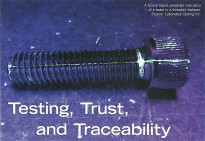 An article from Laboratory Testing Inc. entitled “Testing, Trust, and Traceability” was published in the August 2016 issue of Quality Magazine. The article explains the role nondestructive testing (NDT) plays in ensuring the quality of finished parts and the importance of traceability when testing those parts. Maintaining a link between the parts, the accompanying documentation and the testing they received is extremely important to the manufacturer and to the end user, as it is often the only proof that the material was actually tested.
An article from Laboratory Testing Inc. entitled “Testing, Trust, and Traceability” was published in the August 2016 issue of Quality Magazine. The article explains the role nondestructive testing (NDT) plays in ensuring the quality of finished parts and the importance of traceability when testing those parts. Maintaining a link between the parts, the accompanying documentation and the testing they received is extremely important to the manufacturer and to the end user, as it is often the only proof that the material was actually tested.
Preserving Traceability During Inspection
The article focuses on the steps required to preserve traceability through four different Nondestructive Testing processes: Liquid Penetrant Testing, Magnetic Particle Inspection, Ultrasonic Testing and Radiographic Inspection. Each inspection process can detect surface and sub-surface defects without affecting the operating performance of the inspected products.
The authors emphasize the importance of maintaining traceability throughout the inspection processes and provide guidelines on how this is done, including the following:
- An initial receipt inspection is completed.
- During testing, parts are clearly identified, kept separated and marked as either accepted or rejected according to predetermined specifications and standards.
- The customer receives a test certificate with all relevant inspection information to clearly show the link between the material and the tests results.
Nondestructive Testing Options From LTI
Ultrasonic testing, magnetic particle inspection, liquid penetrant testing, X-ray inspection, visual inspection and hydrostatic pressure testing are performed at LTI. These test methods are available for inspecting tubing, pipes, bars, plates, castings, fasteners and other metal products, as well as some ceramics and plastics.
LTI has the capability to inspect materials and parts in all shapes and sizes, as well as orders of almost any quantity, while safely handling materials weighing up to three tons. The Lab adheres to a strict quality system and procedures to ensure reliable results. Our nondestructive testing inspectors are highly qualified specialists, holding ASNT certifications.
Contact us to find out how LTI’s non-destructive testing can work for you or ask for a quote today.
Related Articles
How Small a Defect Can UT Find
Customers often ask LTI how small a defect ultrasonic testing (UT) can find. This question is very difficult to answer…
Ethics in Laboratory Testing
What could be more important than ethics in the world of materials testing? Testing laboratories have an obligation to adhere…
Quality Considerations in Chemical Analysis
A Well-Planned and Managed Quality Control Program When you need chemical analysis services, you expect to receive accurate testing and…
Spectroscopy Explained
In our new article titled “Spectroscopy Explained”, you’ll learn how chemical testing is performed to answer many questions about material…
Third-Generation Family Member Becomes President
Passing the Baton After 25 years as president of Laboratory Testing Inc. (LTI), Michael J. McVaugh is retiring from the…
Promoting NDT to the Next Generation
Nondestructive Testing (NDT) helps ensure the reliability and safety of materials and products manufactured by many industries, yet it’s a…
